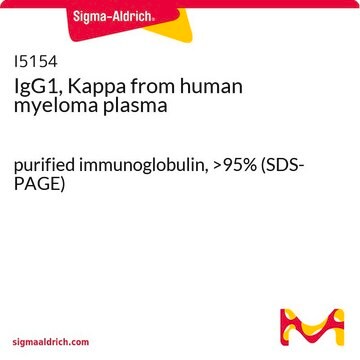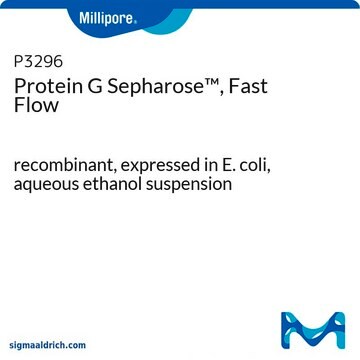M9035
IgG1, Kappa from murine myeloma
clone MOPC 31C, purified immunoglobulin, buffered aqueous solution
Sinónimos:
Mouse IgG1-κ
Iniciar sesiónpara Ver la Fijación de precios por contrato y de la organización
About This Item
Productos recomendados
origen biológico
mouse
Nivel de calidad
conjugado
unconjugated
forma del anticuerpo
purified immunoglobulin
clon
MOPC 31C, monoclonal
Ensayo
≥95% (gel filtration, HPLC)
Formulario
buffered aqueous solution
concentración
≥1 mg/mL
Condiciones de envío
dry ice
temp. de almacenamiento
−20°C
modificación del objetivo postraduccional
unmodified
¿Está buscando productos similares? Visita Guía de comparación de productos
Descripción general
Immunoglobulins (Igs) belongs to the immunoglobulin super-family. IgG is the abundant immunoglobulin in human serum. The four classes of IgG can be IgG1, IgG2, IgG3 and IgG4.
Mammalian immunoglobins contain either lambda or kappa light chains.
Especificidad
Specificity is determined by mouse monoclonal isotyping strips. The purified immunoglobulin preparation is non-reactive with mouse IgA, IgM, IgG2a, IgG2b, or IgG3.
Aplicación
IgG1, Kappa from murine myeloma has been used in:
- chromatin immunoprecipitation (ChIP)
- immunofluorescence
- immunocapture
- enzyme immunoassay
- immunohistochemistry
Acciones bioquímicas o fisiológicas
IgG1 is the most abundant and its deficiency results in hypogammaglobulinemia. IgG antibody have enormous therapeutic potential and the Fc region is involved the development of therapeutic antibody.
Forma física
Solution in 0.02 M Tris buffered saline, pH 8.0, containing 0.02% sodium azide
Cláusula de descargo de responsabilidad
Unless otherwise stated in our catalog or other company documentation accompanying the product(s), our products are intended for research use only and are not to be used for any other purpose, which includes but is not limited to, unauthorized commercial uses, in vitro diagnostic uses, ex vivo or in vivo therapeutic uses or any type of consumption or application to humans or animals.
Código de clase de almacenamiento
12 - Non Combustible Liquids
Clase de riesgo para el agua (WGK)
WGK 1
Punto de inflamabilidad (°F)
Not applicable
Punto de inflamabilidad (°C)
Not applicable
Equipo de protección personal
Eyeshields, Gloves, multi-purpose combination respirator cartridge (US)
Elija entre una de las versiones más recientes:
¿Ya tiene este producto?
Encuentre la documentación para los productos que ha comprado recientemente en la Biblioteca de documentos.
Los clientes también vieron
Fibronectin-binding protein A of Staphylococcus aureus has multiple, substituting, binding regions that mediate adherence to fibronectin and invasion of endothelial cells
Massey RC, et al.
Cellular Microbiology, 3(12), 839-851 (2001)
Regulation of the transcription factor EB-PGC1alpha axis by beclin-1 controls mitochondrial quality and cardiomyocyte death under stress
Ma X, et al.
Molecular and Cellular Biology, 35(6), 956-976 (2015)
Margarida Varela Dos Santos et al.
Gynecologic oncology, 176, 76-81 (2023-07-22)
To analyze the expression and prognostic role of L1CAM in tubo-ovarian high-grade serous carcinoma (HGSC). L1CAM protein expression by immunohistochemistry was analyzed in 644 HGSC (413 effusions, 231 surgical specimens). Expression was analyzed for association with clinicopathologic parameters and survival.
Margarida Varela Dos Santos et al.
Clinical & experimental metastasis, 41(1), 69-76 (2023-12-23)
The objective of this study was to analyze the expression and prognostic role of the tight junction protein occludin in high-grade serous carcinoma (HGSC). Occludin protein expression by immunohistochemistry was analyzed in 602 HGSC (417 effusions, 185 surgical specimens). Expression
Elisabeth Smogeli et al.
BMC cancer, 16, 596-596 (2016-08-05)
L1 cell adhesion molecule (L1CAM) overexpression has been reported to be strongly associated with poor prognosis in early stage endometrial cancer (EC). We aimed at the validation of L1CAM as a marker of poor prognosis in an independent study population.
Nuestro equipo de científicos tiene experiencia en todas las áreas de investigación: Ciencias de la vida, Ciencia de los materiales, Síntesis química, Cromatografía, Analítica y muchas otras.
Póngase en contacto con el Servicio técnico












